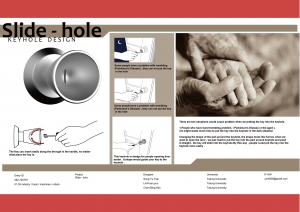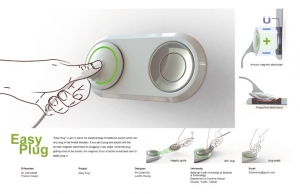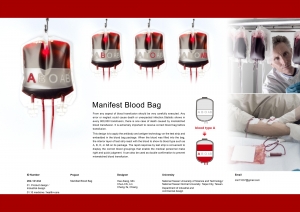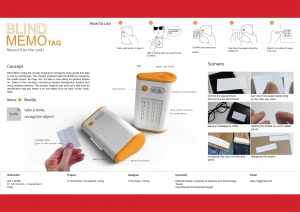全球工業設計獎項種類繁多,其中最受矚目的是德國iF、red-dot、美國IDEA以及日本G-mark四大國際產品設計大獎。此外,概念設計獎由德國iF、red-dot和美國IDEA共同舉辦,主要針對在校學生和新興設計師,為年輕有為的學生提供國際化的亮相平台。
無論是否獲獎,參加國際設計大賽都能有效增強我們的國際經驗。雖然不同的大賽存在偏好和主觀性,但有些大賽相對國際化,被認為是比較客觀的比賽平台。藉此機會,我們可以融入全球設計產業,了解設計實踐或概念表現能力,並認識到自身的優勢和不足之處。我們也可以學習他人的設計實踐,拓寬我們的國際視野。如果能獲得設計獎項,那就再理想不過了,這不僅能證明我們的設計能力,還能大大豐富我們的職業履歷。
我曾經擔任過許多國際設計大賽的評委,無論初賽還是決賽,偶爾也會對那些差一點就通過的作品感到惋惜。因此,我想分享一些自己作為評審的淺薄經驗,給那些正在瞄準國際設計大賽的年輕設計師們一些準備和參考。
1. 日常生活用品
總的來說,最難的,也是最重要的,是我們參與設計競賽的主題選擇。主題選擇的優劣對最終的成敗影響巨大。建議以生活化或全球關注的公共議題作為設計主題的方向。但考慮到評審的國際背景,應避免一些獨特的生活習俗或傳統。如何打動大多數評委,並觸動他們的情感,的確是至關重要的關鍵。因此,我們必須敏銳地觀察日常生活中的物品,找出一些不足之處,以及一些能夠為我們設計新產品提供機會的情境。此外,國際組織或世界新聞關注的議題通常都是不錯的主題,例如減碳、生態保護、救災、救援物資等。 / 至於文化方面,一些本土文化往往能引起評審的興趣。尤其是近年來,中國文化因其在全球市場的重要地位而備受推崇。這些本土文化值得被認可,但其表現仍需讓國際評審能夠理解。過於深奧、冷門或俗套的議題並非適當的題材。在德國的一次決賽中,曾經有一件概念性作品——捲尺,運用了電子紙技術,實現了公制、英制和魯班制的換算。許多評審直到聽了我講解中國及港澳台地區計量器具的使用情況後,才明白這個設計的精髓。不過,下次能否說服評審,或許就得看參賽者的運氣了。因此,題材的選擇更貼合國際通用的生活經驗。
例1-Manifest血袋-2013 iF概念設計獎【TOP 100 】創作者
-台灣科技大學 閔浩翔、林俊吉、蔣正達
2. 設計思考方法的引入
Design thinking is a very popular topic in recent years, andthere are various versions in different detail. In general, there are fivemajor elements in design thinking. The first element is Empathy: to observe andresearch on the audience groups, intimately find out their deep desire,necessity and anticipation; moreover, unknown anticipation. Second, Define: toinsight and clarify, and figure out the problems to solve and opportunitydirections out of the design task. Third, Ideate: to produce various solutionand creativity execution. Fourth, Prototype: to visualize creative concept andconstruct structure model. Fifth, Testing: to communicate with users mutuallyby using prototype and correct the original design concept to be betteraccording to feedback. / After clarifying the topic of our design project,we can define our problems to be solved by applying design thinking methods: toobserve and research, find out the true necessity and desire of audiencegroups. Then we figure out all kinds of possible solutions by creativethinking, through interaction with users via the prototype test, and adjust ourdesign ideas to become more complete. In this way, our design will become moresolid and persuasive with inspiring stories behind. If the process of suchdesign thinking is presented systematically, then generally it tends to befavored by international judges.
Example 2-Blind Memo Tag-2013 iF Concept DesignAward【TOP 100】Creator
-NationalTaiwan University of Science and Technology Tsung, Chih-Hsien
3. Wise and Simple Solutions
After figuring out a direction to solution through designthinking, followed by the axis, the core of design competition is how to solveproblems by creativity. The more simple and wise the solution is, the morepossible it will be recognized by the judges. However, the concept of solutionrequires good manipulation on imagination of design. A good creativity wouldtrigger people’s knowing smile; on the other hand, we should avoid relying onscience and technique for every solution, which is a less responsible practiceof design. I used to see a project, that a small box was claimed to be a supercomputer with powerful wireless connection and moreover, with portableprojector. It is believed to be realized one day; however, that will be attributedto contribution of engineers, not the effort designers. Unless we create somepossibility of the application by using these techniques, to define theinter-design of usage situation, the value of design creativity is hencedetermined.
Example 3-Slide-hole-2013 iF Concept DesignAward【TOP 100】Creator
-TatungUniversity Lin, Kuan-You、Tasi,Sung-Yu、Chan,Bing-Han
4. 清晰醒目的視覺佈局好的專案素材能夠幫助我們發現有意義的問題或機會,從而透過設計開發出富有創意的解決方案。接下來,我們需要將設計成果呈現給評審,讓他們感受到我們設計理念的卓越。因此,最終的視覺佈局技巧將成為晉級決賽的關鍵。 / 近年來,越來越多年輕的設計師熱衷於參與國際設計大賽。知名賽事的參賽作品通常多達數千件甚至數萬件。雖然主辦單位會將評審分為初審、最終審查和系統性評審,但每位評審仍需評估三、四百件作品。無論是網路評審還是實體色彩評審,評審的工作量都非常大。因此,在大會要求的佈局中,設計作品需要清晰簡潔地呈現,並配以精準的英文描述,並透過視覺傳達吸引評審的注意力。作品越早被評審注意到和理解,我們晉級決賽的機會就越大。

範例四-Easy Plug-2013 iF概念設計獎【TOP 100 】創作者
-國立雲林科技大學 黃瑞敏、吳品傑
以上是我作為評審的一些建議,希望對有志於參加國際設計大賽的年輕設計師們有所參考。也祝福大家在比賽中能夠享受比賽的樂趣,並取得最好的結果。




